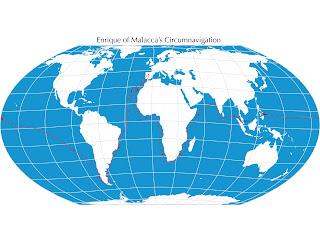 |
| Early photograph of a Patagonian. |
Magellan and his crew captured two of the Patagonian giants and put them in chains to be brought back to King Charles—a souvenir of sorts.
Both died at sea, one in the Atlantic, one in the Pacific.
It's a wonder what must have been going through their minds. These beings had come from the sky in giant boats and now were whisking the giants away. To where and for what purpose?
The Patagonian that Antonio Pigafetta got to know aboard the Trinidad made that first journey through Magellan's strait. He would have witnessed the mysterious views of white, jagged peaks and rocky coves along with the crew. Was this a magical river that led into the sky, to the end of earth and life as the giant had known it?
His European shipmates would have viewed the strait with equal wonder. They had left the world they'd known, as it was known, sailed well beyond the end of all maps even before meeting their giant. To them the passage may also have seemed like a river to the afterlife, and for many it was.
Soon they entered a new ocean, one so utterly calm that Magellan dubbed it the Pacific sea. Still waters and a miracle wind at their sails sent them speeding into the unknown faster than they had ever traveled, but where they expected to find island paradises rich in spices and wealth they found only endless open waters that each day cast an image of ever-greater isolation.
Open seas proved the Captain-General's strait was not a passage to a Moluccan paradise but a gateway to endless nothingness.
The Patagonian would have witnessed many of Magellan's crew lose hope as impending death, starvation, and scurvy replaced thoughts of a world left behind. As he contemplated his own unlikely end, the giant would have seen these godlike crewmen face their own.
Were these minor demons, Cheleule, that the giant found himself among, since they suffered and died just like people?
As Antonio Pigafetta, Magellan's chronicler, wrote, "this malady was the worst, namely that the gums of most part of our men swelled above and below so that they could not eat. And in this way they died, inasmuch as twenty-nine of us died, and the other giant died, and an Indian of the said country of Verzin [Rio]."
Pigafetta noted that those refusing to eat rats were among the first to go. He had also noted that the Patagonian giant on the Trinidad ate rats without even skinning them first, so the giant likely lasted longer than others.
Here is Pigafetta's account of the captured Patagonian's end:
Once I made the sign of the cross, and, showing it to him, kissed it. He immediately cried out “Setebos” [great god] and made me a sign that if I made the sign of the cross again, Setebos would enter into my body and cause it to burst.
When that giant was sick, he asked for the cross, and embracing it and kissing it many times, desired to become a Christian before his death. We called him Paulo.
The name may have left one odd final thought for a Patagonian native in winter 1521 as he succumbed to death in the Pacific: "And they called me Paulo."
Part 1. First Contact Patagonia: Magellan and the Patagonians, Pigafetta 1
Part 2. Giants and Guanacos: Magellan and the Patagonians, Pigafetta 2
Part 3. Giant John: Magellan and the Patagonians, Pigafetta 3
Part 4. How to Capture Patagonian Giants: Magellan and the Patagonians, Pigafetta 4
Part 5. Culture of the Giants: Magellan and the Patagonians, Pigafetta 5
Part 6. Words of the Patagonians: Magellan and the Patagonians, Pigafetta 6
Part 7. Journey's End: Magellan and the Patagonians, Pigafetta 7
Find us:

